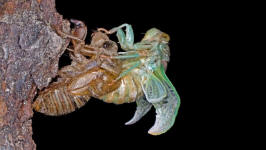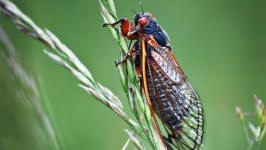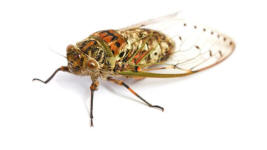|
Cicadas are the elders of the insect world. Some species of
cicada live up to 17 years, though most of the time is spent
underground.
Most closely related to leaf, tree, and plant hoppers, cicadas are
large singing insects, often colloquially called locusts. This
is incorrect, as locusts are species of swarming grasshoppers.
Because the periodical cicadas emerge in such enormous numbers, of
up to 1.5 million individuals per acre, over large areas along the
eastern seaboard and west to Kansas, they were interpreted as
locusts by early American settlers, an error
which has continued to the present. Cicadidae
is one of two families of cicadas (order Hemiptera) which includes
an estimated 2500 described species in three subfamilies and many
others yet to be described, found in temperate to tropical climates
on every continent in the world except Antarctica. The other
cicada family is the primitive Australian Tettigarctidae (hairy
cicadas), which contains two species. Within these groups
there are the ‘dog-day’ cicadas which are very dark with greenish
markings and spend four to seven years under ground before emerging
in July and August.
New groups of young are born every year, so every year
different generations emerge. The ‘Periodical’ cicadas are dark with red
eyes. These emerge in late May and early June after 14 to 17 years
under ground.
Above ground, male cicadas fill the air with shrill buzzing
sounds, the result of small drum-like plates called tymbals, on the
abdomen of the male, that the cicada vibrates rapidly. While many
people find the sound annoying, the male cicada uses it to attract
female cicadas for mating. Both male and female cicadas die after
about five weeks above ground. Female cicadas lay from 200 to 600
eggs in tiny holes made in branches and twigs in trees and shrubs.
Cicada young—called nymphs—hatch from the eggs and immediately drop
to burrow underground, where they attach to tree roots. The nymphs
remain attached to the roots, sucking tree sap, for most of their
lives.
Depending on the
species the nymphs live up to 2.5 meters (8.2 feet) below ground,
feeding on plant sap from roots, which they pierce with their long
proboscis. In the nymphs' final developmental stage, they dig
their way to the surface with powerful digging legs, pull themselves
up to a plant stem, and molt into an adult with prominent eyes and
clear wings. They leave behind a very recognizable larval
casing, with the slit on the dorsal side from whence the adult
emerged clearly visible. Cicadas are quite diverse in looks and
behaviors. Most adults are between 2 to 5 cm (0.79–2.0 in) in
length. Cicadas are eaten around the world by many cultures and
different animals and are used in traditional medicines in Asia, and
surface in many stories and customs. While a cicada might
mistake you for a food source and try to poke you with its
proboscis, these insects do not sting or bite and pose no danger to
humans.
RETURN TO TOP Page last updated :07/16/2018 |


